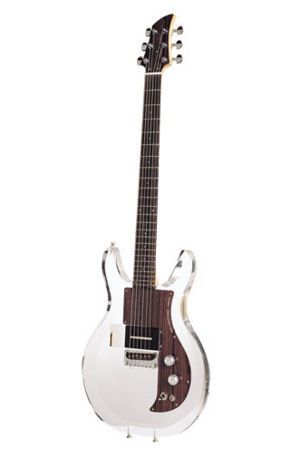Difference between revisions of "Ampeg Dan Armstrong"
| (6 intermediate revisions by the same user not shown) | |||
| Line 1: | Line 1: | ||
[[File:ADAG LG.jpg | right | thumb | Ampeg Dan Armstrong]] | [[File:ADAG LG.jpg | right | thumb | Ampeg Dan Armstrong]] | ||
[[File:MattDanArm1.jpg | right | thumb | Matt and the Dan Armstrong]] | |||
{{Guitarbox | {{Guitarbox | ||
| Name = Dan Armstrong | | Name = Dan Armstrong | ||
| Line 13: | Line 14: | ||
| Electronics = Three-way tone circuit | | Electronics = Three-way tone circuit | ||
| Pickups = Custom removable pickups | | Pickups = Custom removable pickups | ||
| Special = None | |||
}} | }} | ||
The Ampeg Dan Armstrong is a see-through | The Ampeg Dan Armstrong is a see-through range of guitars and basses created by Dan Armstrong in 1969. | ||
The guitar features a custom removable pick-ups, a 3-way tone circuit and a 24-fret hard maple neck. The unique choice of body material eliminates unwanted virbations and frequencies while playing the guitar, while still producing sustain. The basses feature a short-scale neck. Artists who are or have played this guitar feature Dave Grohl, of [[Foo Fighters]], Josh Homme of [[Queens of the Stone Age]], John Frusciante of [[Red Hot Chili Peppers]], Lou Reed of Velvet Underground, Bill Wyman of The Rolling Stones, just to name a few. | |||
[[Matthew Bellamy|Bellamy]] used an Ampeg Dan Armstrong in the [[Supermassive Black Hole (video) | Supermassive Black Hole video]]. [[Floria Sigismondi]], the director of the video, decided to put a piece of "wallpaper" on the guitar to make it look original. | [[Matthew Bellamy|Bellamy]] used an Ampeg Dan Armstrong in the [[Supermassive Black Hole (video) | Supermassive Black Hole video]]. [[Floria Sigismondi]], the director of the video, decided to put a piece of "wallpaper" on the guitar to make it look original. | ||
| Line 21: | Line 25: | ||
According to Premier Guitar, the Dan Armstrong was also used for recording [[Simulation Theory (album)|Simulation Theory]] in 2018.<ref>https://www.premierguitar.com/articles/28320-muses-matt-bellamy-unusual-collisions?page=2</ref> | According to Premier Guitar, the Dan Armstrong was also used for recording [[Simulation Theory (album)|Simulation Theory]] in 2018.<ref>https://www.premierguitar.com/articles/28320-muses-matt-bellamy-unusual-collisions?page=2</ref> | ||
==References== | == References == | ||
</ | <references/> | ||
{{Backto | guitars}} | {{Backto | guitars}} | ||
Latest revision as of 17:29, 4 August 2019
| Dan Armstrong | |
|---|---|
| Manufacturer | Ampeg |
| Used |
|
| Body type | Solid |
| Neck joint | Bolt-on |
| Body covering | See-through |
| Wood | Body: Plexiglass Neck: Hard Maple Fingerboard: Rosewood (24 frets) |
| Bridge | Fixed |
| Electronics | Three-way tone circuit |
| Pickup(s) | Custom removable pickups |
| Special circuits | None |
The Ampeg Dan Armstrong is a see-through range of guitars and basses created by Dan Armstrong in 1969.
The guitar features a custom removable pick-ups, a 3-way tone circuit and a 24-fret hard maple neck. The unique choice of body material eliminates unwanted virbations and frequencies while playing the guitar, while still producing sustain. The basses feature a short-scale neck. Artists who are or have played this guitar feature Dave Grohl, of Foo Fighters, Josh Homme of Queens of the Stone Age, John Frusciante of Red Hot Chili Peppers, Lou Reed of Velvet Underground, Bill Wyman of The Rolling Stones, just to name a few.
Bellamy used an Ampeg Dan Armstrong in the Supermassive Black Hole video. Floria Sigismondi, the director of the video, decided to put a piece of "wallpaper" on the guitar to make it look original.
According to Premier Guitar, the Dan Armstrong was also used for recording Simulation Theory in 2018.[1]

